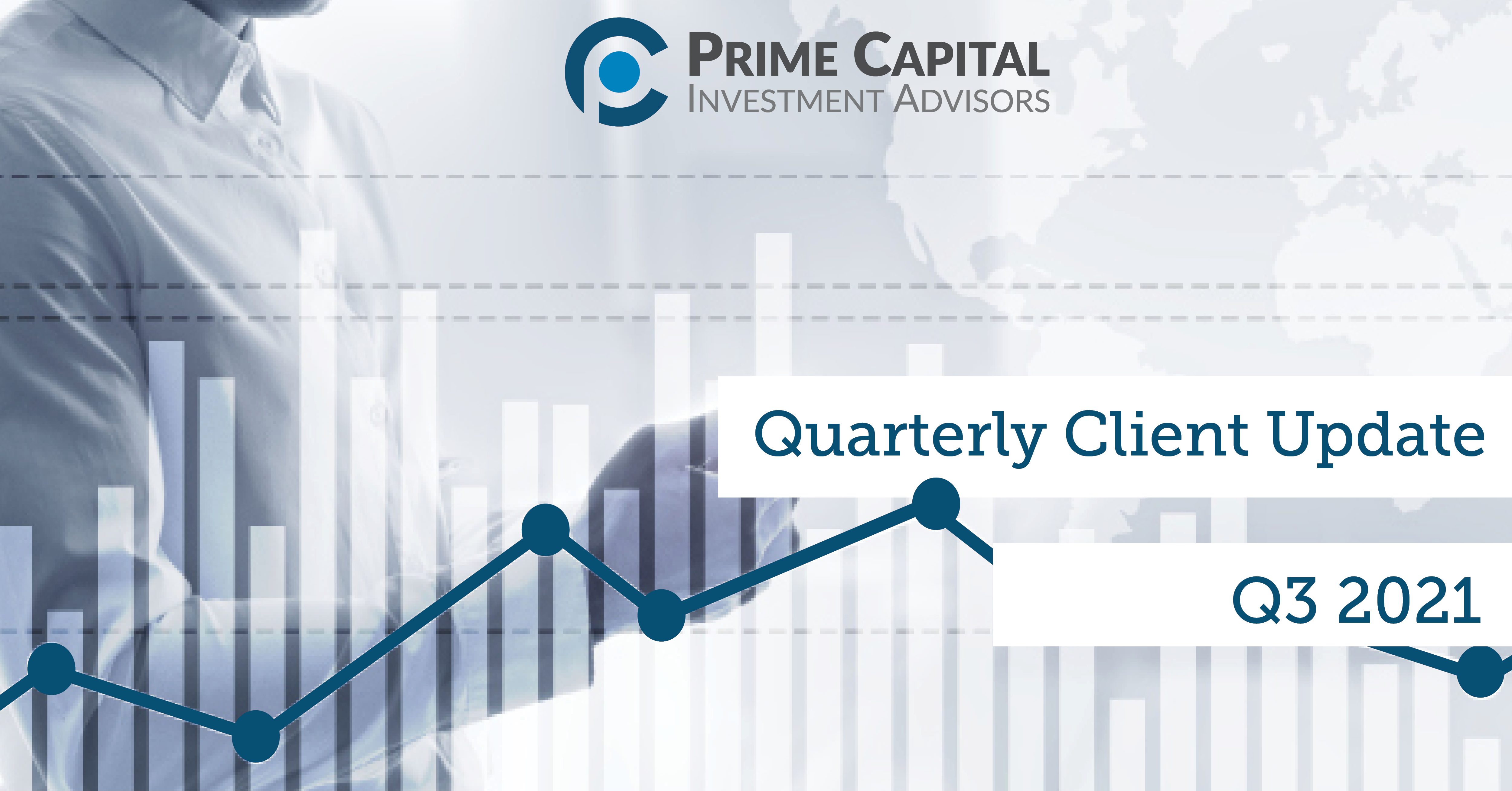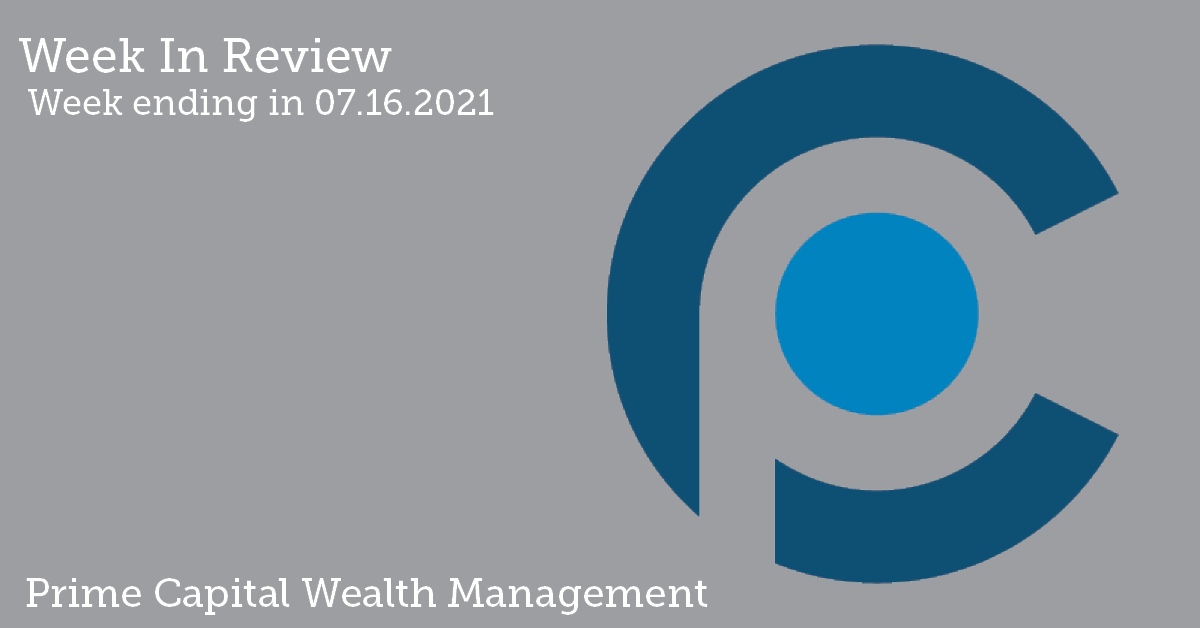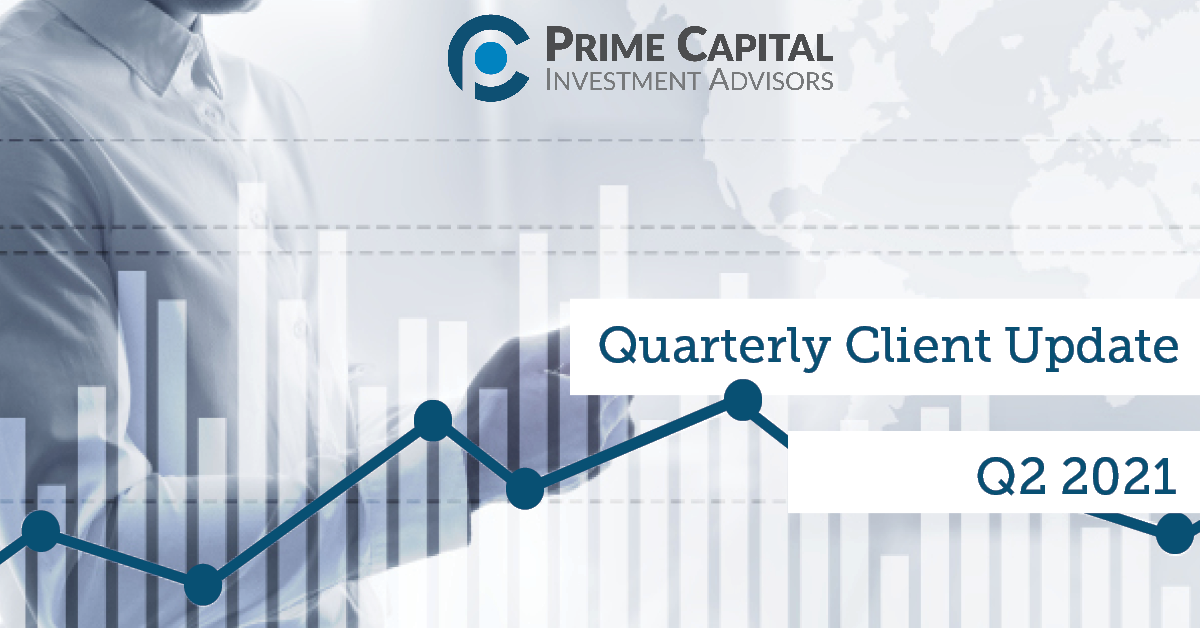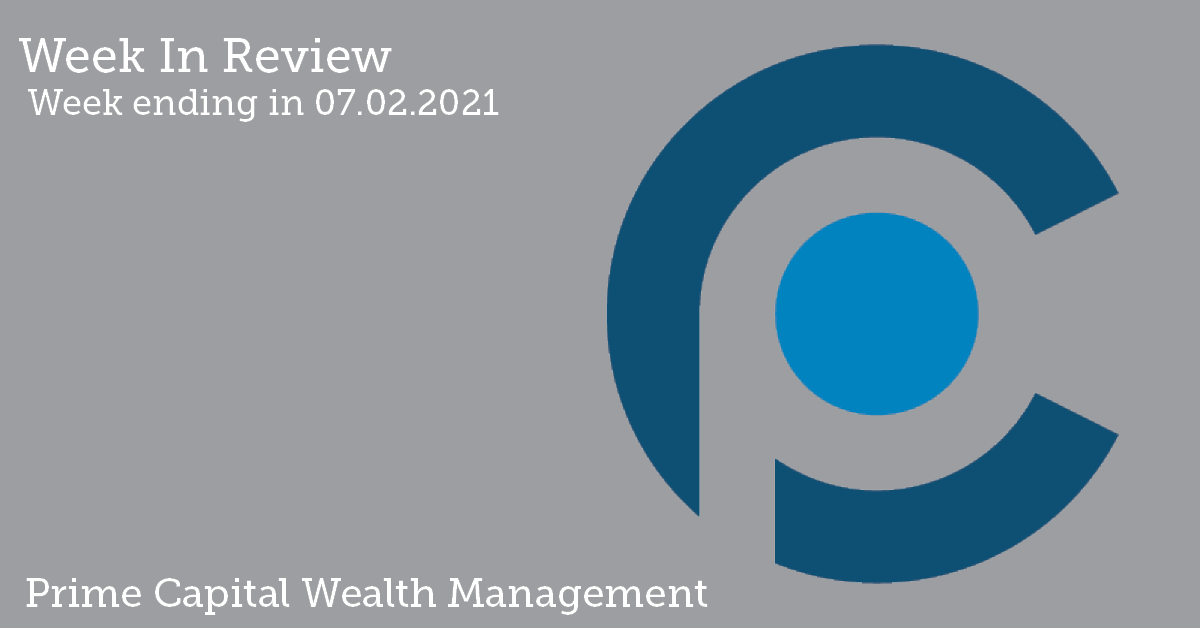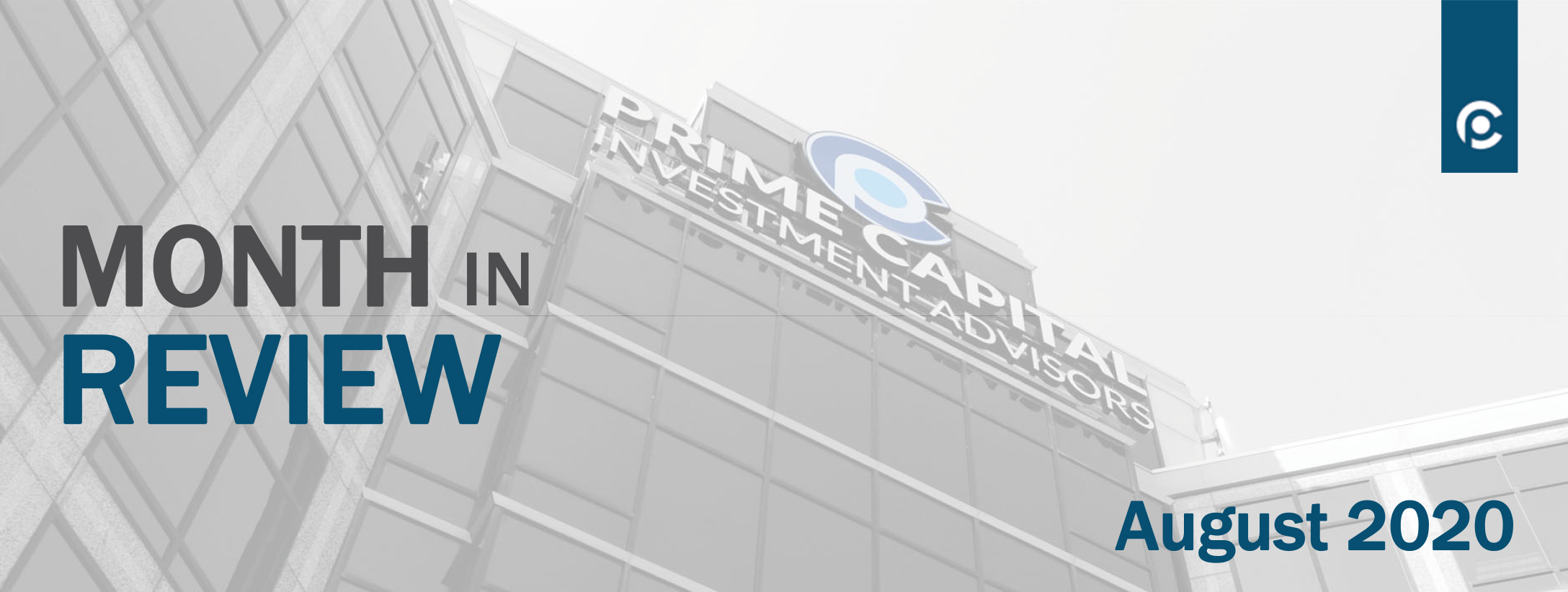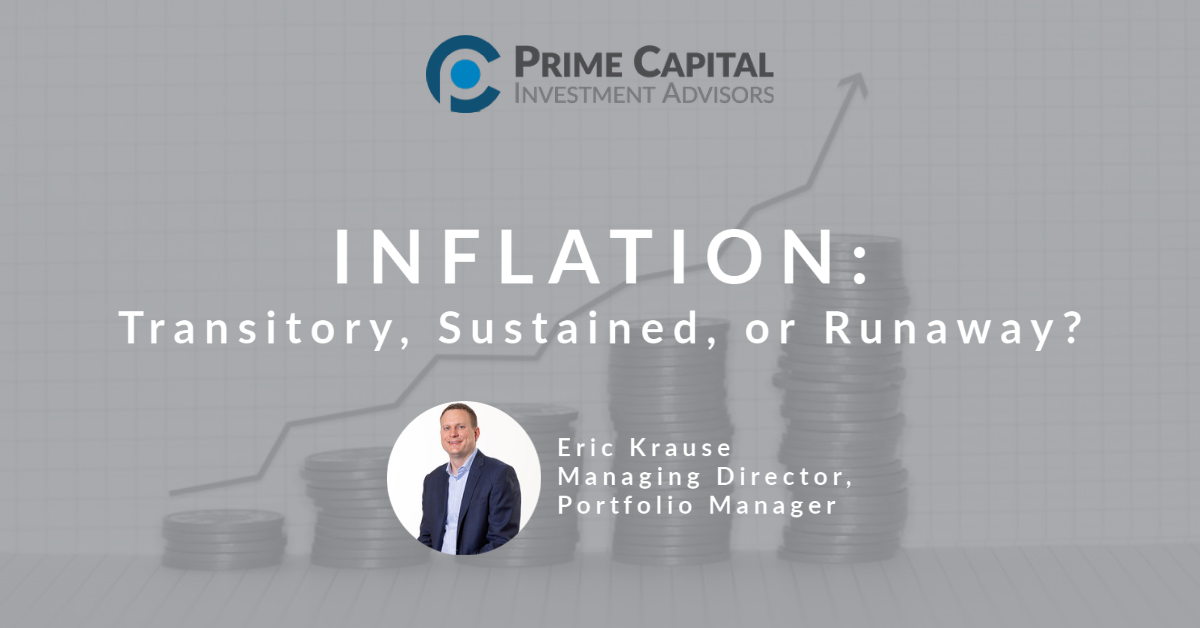With inflation at multi-decade highs and inflation expectations inching up, the Fed has reprioritized its focus from supporting growth to quickly taming inflation. The Fed has stated (unequivocally, to our ears) that they would gladly risk a recession now via restrictive policy to avoid the bigger risk of higher and more entrenched inflation later. This is the right long-term policy, but means that economic growth will slow in the near term.
Wendy Prestwood Joins Prime Capital Investment Advisors
PCIA is pleased to announce Wendy Prestwood, CMFC, CRPC, has joined the firm as Partner and Wealth Advisor. She has 25 years of experience in the industry and is based out of the Overland Park, KS office.
Mary Lucas Joins Prime Capital Investment Advisors
Prime Capital Investment Advisors (PCIA) is pleased to announce Mary Lucas as its new director of financial planning and client experience. In her new role at PCIA, Lucas will use her experience to take the firm’s financial planning practice to the next level.
Q3 Quarterly Client Update
As we turn our calendars from the hot summer to temperate fall months, risk assets have started to cool with the weather, with volatility re-emerging in markets. Equities began the quarter by continuing their upward trend and breaking through record highs, driven by a dip in interest rates and robust corporate earnings reports.
Week-in-Review: Week ending in 07.16.21
The Bottom Line
● U.S. equities fell for the first time in four weeks. All the major US equity indices posted a negative return for the week, but still maintain healthy year to date figures.
● The 10-Year yield started the week on the upswing but couldn’t cross the 1.42 level. Ultimately, it resumed it’s decline and ended the week down -7 bps, settling at 1.29.
● The markets had plenty of economic news to digest this week with June inflation data releases, retail sales, labor market reports, and major US banks kicked off earnings season.
Dog Days of Summer
Markets are traditionally tepid during the summer months, and this summer might fall victim to the adage of the “Dog Days of Summer”. The S&P started the week just as it finished last week, carrying an increase of +0.49% up to Wednesday. This didn’t last as inflation metrics came out higher than expected and above consensus estimates on retail sales weren’t able to revive the indices on Friday. The Russell took the brunt of the selling pressure, posting a -5.12% loss for the week. Major US banks reported their earnings, top line numbers were propped up by robust investment banking division revenues, but other segments couldn’t boast similar results. Concerns over the spread of the delta variant continued to weigh on European equities with the STOXX 600 posting a -0.64% loss for the week. After a difficult week last week, Japanese equities were able to post a modest gain of +0.22% for the week. Volatility wasn’t only present in the equity markets, the 10-year yield sent investors on a ride with rates pushing higher at the beginning of the week, but the 10-year wasn’t able to surpass the 1.42 level and finally ended the week down -7bps to 1.29 as investors searched for a haven.
Digits & Did You Knows
IT’S DIFFERENT — The Federal Reserve measures inflation using the “Personal Consumption Expenditures” (PCE) price index while the government uses the “Consumer Price Index” (CPI) for the “cost of living adjustment” (COLA) to increase Social Security retirement benefits. The CPI gives “housing” prices a 42.1%weighting in its calculation, while the PCE gives “housing” just a 22.6% weighting. The CPI gives “medical care” prices an 8.8%weighting in its calculation, while the PCE gives “medical care” a 22.3% weighting. (source: Federal Reserve, BTN Research).
NOT JUST KIDS — 19% of Americans that have outstanding student loan debt from college are over age 50, i.e., 8.7 million borrowers out of 44.7 million total borrowers. (source Federal Reserve Bank of New York, BTN Research).

Click here to see the full review.
—
Source: Bloomberg. Asset‐class performance is presented by using market returns from an exchange‐traded fund (ETF) proxy that best represents its respective broad asset class. Returns shown are net of fund fees for and do not necessarily represent performance of specific mutual funds and/or exchange‐traded funds recommended by the Prime Capital Investment Advisors. The performance of those funds may be substantially different than the performance of the broad asset classes and to proxy ETFs represented here. U.S. Bonds (iShares Core U.S. Aggregate Bond ETF); High‐YieldBond(iShares iBoxx $ High Yield Corporate Bond ETF); Intl Bonds (SPDR® Bloomberg Barclays International Corporate Bond ETF); Large Growth (iShares Russell 1000 Growth ETF); Large Value (iShares Russell 1000 ValueETF);MidGrowth(iSharesRussell Mid‐CapGrowthETF);MidValue (iSharesRussell Mid‐Cap Value ETF); Small Growth (iShares Russell 2000 Growth ETF); Small Value (iShares Russell 2000 Value ETF); Intl Equity (iShares MSCI EAFE ETF); Emg Markets (iShares MSCI Emerging Markets ETF); and Real Estate (iShares U.S. Real Estate ETF). The return displayed as “Allocation” is a weighted average of the ETF proxies shown as represented by: 30% U.S. Bonds, 5% International Bonds, 5% High Yield Bonds, 10% Large Growth, 10% Large Value, 4% Mid Growth, 4%Mid Value, 2% Small Growth, 2% Small Value, 18% International Stock, 7% Emerging Markets, 3% Real Estate.
Advisory services offered through Prime Capital Investment Advisors, LLC. (“PCIA”), a Registered Investment Adviser. PCIA doing business as Prime Capital Wealth Management (“PCWM”) and Qualified Plan Advisors (“QPA”).
© 2021 Prime Capital Investment Advisors, 6201 College Blvd., 7th Floor, Overland Park, KS 66211.
Q2 Quarterly Client Update
And the beat goes on…
Essentially treading water for the first half of the quarter, markets found their footing and finished positive across every major asset class. Continued vaccination success, massive amounts of fiscal and monetary stimulus, solid economic activity, and earnings acceleration all contributed to the investor optimism that witnessed the S&P 500 deliver positive quarterly results for the fifth consecutive quarter, which is the longest consecutive streak since the nine-quarter stretch that ended in 2017. Though many of the quarter’s headlines centered around fear-invoking risks like inflation and sooner than expected modifications to the Fed’s accommodative policy, the markets appeared unphased as concerns of growth moderation sent yields lower and equities higher. While still lagging other major US equity markets year-to-date with a return of 12.54%, as markets shifted toward higher quality, the more interest-rate sensitive and growth-oriented NASDAQ led the charge with a second-quarter return of 9.49%, as compared to returns on the S&P 500 of 8.55% and 15.25% for the quarter and year, respectively. While only delivering returns of 4.29% in the second quarter, US small-cap stocks, as measured by the Russell 2000 index, garnered solid returns for the year of 17.54%, only to be outdone year-to-date by the S&P MidCap 400 return of 17.59%.
With uneven COVID containment across emerging market countries, along with varying degrees of inoculation success, surging commodity prices, and falling US yields, the MSCI Emerging Market Index delivered a positive return of +5% in the second quarter; bringing the year’s return across developing countries to 7.4%. Conversely, foreign developed countries (primarily Europe and Japan) continue to lag the US in vaccine rollout progress, though France and Germany are approaching 50% of their populations receiving at least one inoculation. Rising concerns over the Delta variant continue to threaten the near-term recovery. Fortunately, recent vaccination success and easing of some travel restrictions drove the cyclical heavy MSCI EAFE Index (Energy, Financials, Industrials, and Materials make up more than 40% of the index) +5.2% for the period, bringing the total for the year to +8.8%
Despite high levels of inflation reported over the quarter, long-term inflation expectations are actually down on average. When coupled with an overly accommodative and reassuring Fed, along with the looming fiscal cliff and Delta variant posing risks to the expansion, the market witnessed the yield on the 10-Year Treasury contract about 30 basis points (0.30%) to end the second quarter at 1.45%; still up more than 0.50% for the year. While the inverse relationship between bond prices and yields pushed the return on the Bloomberg Barclays U.S. Aggregate Bond Index up 1.8% for the quarter, the index remains down -1.6% for the year.
Economy
Though first quarter GDP accelerated at a 6.4% rate, the US still sat below its pre-pandemic growth levels. Massive amounts of Congressional and monetary stimulus continued to drive economic activity back into positive territory in the second quarter. The Conference Board forecasts that US Real GDP in the second quarter will rise to a 9.0% annualized rate and 6.6% year-over-year for 2021. While Bloomberg forecasts have moderated in recent weeks, they’re still anticipating second-quarter growth of 10% (from 11% in March), and 7.2% for 2021 (from 7.7% in March). Growth of 7.2% for the year would be the fastest annual rate since the economy surged out of the 1981-1982 recession. With the effects of the March Congressional stimulus package fading, several key economic indicators have demonstrated some recent softening. While consumer spending was robust in the first quarter (up +11.4%, according to Bloomberg), we’ve witnessed a normalization in retail spending in both April and May. Furthermore, as the economy has continued to reopen, consumers have started to shift their spending preferences away from goods and more toward experiences and services, like dining out and traveling. In general, consumers appear poised to drive significant pent-up demand, as evidenced by their elevated savings of 14.9% (more than double the post-Great Financial Crisis average), unprecedented consumer net worth, and an M2 Money Supply of more than four trillion dollars above average levels – up 18% year-over-year, and 30% higher since February 2020. Given that the consumer comprises roughly 70% of our economy’s output, spending should serve as a significant driver for economic growth for the remainder of the year. That spending should be supported further in the intermediate term from both the monthly child tax credit payments that are going out this month, coupled with the eventual spend-down of excess savings.
The Fed, Inflation, and Labor Market
Over the course of 2021, equity markets have become increasingly more dependent on overly accommodative central bank policy, where Fed policy appears priced to perfection and risks of a policy mistake appears more likely than not, hence the flattening yield curve. Though continually pressured, the Federal Reserve has remained resolute in their current policies and messaging, maintaining their accommodative stimulus through open-ended Quantitative Easing (QE4) and keeping rates historically low. This “anything it takes” mentality has seen the Fed’s balance sheet balloon to more than $8 trillion, with no real signs of slowing. The Fed is currently purchasing $120 billion ($80 billion US Treasury securities and $40 billion in mortgage-backed securities) per month and has indicated the intent to maintain this pace through 2021 and possibly into 2022, before beginning to taper their purchases. As we’ve communicated in the past, taper does not mean that the Fed will halt buying bonds; it means that they will slow the pace of their purchases. Tapering could reduce purchases from $120 billion per month to approximately $100 billion per month in a transparent and well-communicated manner. Perhaps the two most monumental changes coming out of the surprisingly hawkish June Federal Open Market Committee was the mention of “talking about talking about tapering” and revising their projection for rate increases from 2024 to 2023. The Fed continues to communicate that their decisions will hinge on actual data and not forecasted data. In the third quarter of last year, the Fed changed its policy framework to achieve 2% inflation and adopted a soft, or flexible, inflation averaging approach. This soft approach would hypothetically allow inflation to run above 2% for an undisclosed period, as long as the average falls back 2% over the long run. With so much emphasis on inflation, what’s often overlooked is the Fed’s dual mandate to both average their 2% inflation target and their commitment to achieving “substantial further progress” toward the goal of maximum employment.
Inflation measures the rate of increase in prices of goods over a given period, and high inflation levels can damage productivity and economic growth. Last year, prices fell in March and April and remained low in May, creating a low base for future year-over-year readings – resulting in price level changes that might be slightly exaggerated. But in looking at the economic data, it’s hard to deny inflation currently exists. The Consumer Price Index (CPI), a prominent measure of inflation, witnessed Headline CPI come in at 5% and 5.4% in May and June, respectively, which are the highest readings since 2008. After stripping out the more volatile food and energy components, the Core CPI registered its highest reading since 1991, 3.8% and 4.5% for the same respective months. While the increases in the basket of goods measured in the CPI in April, May, and June did include some noise resulting from the base effect, most of the price increases have been a result of significant supply chain disruptions, coupled with a significant surge in demand. During the pandemic, inventory levels were significantly depleted, and once the economy began to reopen, demand surged, causing a bottleneck in the supply chains. Many consumers have felt this if they’ve tried buying a car, buying a house, or even building a deck. This type of supply chain disruption is relatively normal during recovery periods and can be seen as mostly transitory. Therein lies much of the debate around inflation – will it be transitory (temporary) or structural (sticky)? When looking at the most recent two CPI reports, more than half of the total increase in Core CPI can be attributed to used cars, rental cars, hotels, and airfare. These small categories only represent a combined total of Core CPI of about 6%. Their large price jumps are due to reopening and supply chain disruptions, both temporary, or transitory. Conversely, the larger components like rent and healthcare represent roughly 49% of Core CPI and have experienced only modest price gains; though the two consecutive readings of 0.3% for rents is worth noting and will be important to monitor going forward. One of the major issues causing disruptions across nearly every economic sector is semiconductor, or chip, shortages. Our everyday lives have become dependent on chips; they’re found in nearly everything from automobiles, dishwashers, phones, computers, to microwaves, etc. Through May, the average order-to-delivery interval reached all-time highs of 18 weeks. In other words, if a single chip was ordered in May, it took 18 weeks for that single chip to be delivered – hence the severe disruption in production and significant spike in new and used car prices.
pandemic, inventory levels were significantly depleted, and once the economy began to reopen, demand surged, causing a bottleneck in the supply chains. Many consumers have felt this if they’ve tried buying a car, buying a house, or even building a deck. This type of supply chain disruption is relatively normal during recovery periods and can be seen as mostly transitory. Therein lies much of the debate around inflation – will it be transitory (temporary) or structural (sticky)? When looking at the most recent two CPI reports, more than half of the total increase in Core CPI can be attributed to used cars, rental cars, hotels, and airfare. These small categories only represent a combined total of Core CPI of about 6%. Their large price jumps are due to reopening and supply chain disruptions, both temporary, or transitory. Conversely, the larger components like rent and healthcare represent roughly 49% of Core CPI and have experienced only modest price gains; though the two consecutive readings of 0.3% for rents is worth noting and will be important to monitor going forward. One of the major issues causing disruptions across nearly every economic sector is semiconductor, or chip, shortages. Our everyday lives have become dependent on chips; they’re found in nearly everything from automobiles, dishwashers, phones, computers, to microwaves, etc. Through May, the average order-to-delivery interval reached all-time highs of 18 weeks. In other words, if a single chip was ordered in May, it took 18 weeks for that single chip to be delivered – hence the severe disruption in production and significant spike in new and used car prices.
Over the coming months, perhaps the most telling variable to monitor for clarity around inflation’s transitory or structural nature will be wage growth. It’s difficult for inflation to be sticky or structural without upward wage pressure. June’s 3.6% year-over-year wage growth is worth noting, though not overly concerning. Should the labor market start to exhibit the same pricing power as we’ve witnessed in commodities, we could witness a wage/price spiral, causing yields to normalize quicker than anticipated and indicating inflation might last longer than expected. When wages increase, businesses must increase the cost they charge for their goods and services to compensate for the higher wages, adding to inflationary pressures. If prices remain elevated, workers will eventually demand another wage increase to offset the increase in their cost of living – making inflation more structural. To correct the labor shortages and hire workers to meet surging demands, employers are getting creative to hire and retain workers, including higher wages. Several retailers, like Walmart, have raised their internal minimum wages to $15 per hour or more. Once these changes are made, an employer can’t reduce employees’ salaries, making these changes more permanent. Additionally, during first-quarter corporate earnings announcements, nearly every announcement mentioned inflation and the rising input costs applying pressure to their margins, and furthermore, their intentions to pass those increased costs along to consumers. Much like wage increases, if a company can successfully pass along cost increases, and consumers are willing to pay those higher prices, then once supply chain disruptions normalize and their cost of goods fall in line, many companies are not willing to slash consumer prices – again making inflation more structural and stickier than transitory and temporary.
We partially agree with the Fed and Treasury Secretary, Janet Yellen that the current supply chain disruptions will start to work out, and price gains will start to normalize. We believe that inflation will be transitory in the sense that it should start to moderate sometime in the third or fourth quarter of this year from its current levels. However, we also think that we could be headed for a regime change in future inflation. I n other words, the post-Great Financial Crisis inflation averaged less than 2%, and we wouldn’t be surprised to see the next several years running closer to the 3% range. Outside of that view, when looking at the June CPI numbers of 5.4% and 4.5% on Headline and Core, respectively, it’s understandable investors are fearful. However, we are still dealing with some base effects, which are causing overstated numbers. This same base effect will also impact year-over-year CPI data as we approach the second and third quarters of next year, except then we’ll experience a reverse base effect. This time next year, the base will be these elevated inflation results currently being reported, which could produce negative year-over-year CPI readings. Given the cliff experienced during the heart of the pandemic, followed by sharp V- shaped reversals, we anticipate several variables to suffer from base effects for at least another year or so, continuing to insert noise into the data. When looking at the metrics closer, about 50% of the components tracked in the CPI basket that contributed to growth came from transitory components like buying used cars (up 45% YoY) and dining away from home. Therefore, as production comes back online, many supply chain disruptions should dissipate and lead to a moderation in inflation.
n other words, the post-Great Financial Crisis inflation averaged less than 2%, and we wouldn’t be surprised to see the next several years running closer to the 3% range. Outside of that view, when looking at the June CPI numbers of 5.4% and 4.5% on Headline and Core, respectively, it’s understandable investors are fearful. However, we are still dealing with some base effects, which are causing overstated numbers. This same base effect will also impact year-over-year CPI data as we approach the second and third quarters of next year, except then we’ll experience a reverse base effect. This time next year, the base will be these elevated inflation results currently being reported, which could produce negative year-over-year CPI readings. Given the cliff experienced during the heart of the pandemic, followed by sharp V- shaped reversals, we anticipate several variables to suffer from base effects for at least another year or so, continuing to insert noise into the data. When looking at the metrics closer, about 50% of the components tracked in the CPI basket that contributed to growth came from transitory components like buying used cars (up 45% YoY) and dining away from home. Therefore, as production comes back online, many supply chain disruptions should dissipate and lead to a moderation in inflation.
The rest of the Quarterly Update covers the Federal Reserve, Congressional Stimulus, and other Implications moving forward. Read more.
—
The preceding commentaries are (1) the opinions of Chris Osmond and Eric Krause and not necessarily the opinions of PCIA, (2) are for informational purposes only, and (3) should not be construed or acted upon as individualized investment advice. Investing involves risk. Depending on the types of investments, there may be varying degrees of risk. Investors should be prepared to bear loss, including total loss of principal. Past performance is no guarantee of future results.
Advisory services offered through Prime Capital Investment Advisors, LLC. (“PCIA”), a Registered Investment Adviser. PCIA: 6201 College Blvd., 7th Floor, Overland Park, KS 66211. PCIA doing business as Qualified Plan Advisors (“QPA”) and Prime Capital Wealth Management (“PCWM”).
Week-in-Review: Week ending in 07.09.21
The Bottom Line
● U.S. equities advanced for the third week in a row and sixth in the last seven. Major U.S. indices closed at record highs, overcoming a big drop on Thursday over fears of the spreading Delta variant and slowing global growth.
● Despite a +7 basis point rally on Friday, the yield on the 10‐year U.S. Treasury dropped ‐6basis points forthe week, closing at 1.36%. At its lowest point on Thursday the 10‐year was down near 1.25%.
● The Labor Department reported that May job openings rose by +16,000, pushing the total to a new record high of 9.2 million jobs, which nearly matches the 9.3 million unemployed Americans that are actively seeking jobs.
2021✔️Friday✔️Record Highs✔️
In what seems to have become a regular occurrence in 2021, major U.S. indices set fresh all‐time highs on Friday, capping an otherwise wobbly week. It took a big rally on Friday to overcome Thursday’s losses over fears of the Delta COVID variant spreading and worries that global growth was peaking. It was the third straight weekly gain for the S&P 500 and the sixth week of gains in the last seven. The Dow Jones Industrial Average and Nasdaq Composite also finished at record highs. Though small caps fell short of record highs, falling ‐1.1% for the week, the Russell 2000 did rebound+2.0% on Friday. The Friday stock rally was spurred by news that Pfizer is working on a booster shot to combat the Delta variant and China’s central bank was boosting liquidity by reducing the amount of cash its banks must hold in reserve. The yield on 10‐year U.S. Treasury has fallen for two consecutive weeks, and fell as low as 1.25% on Thursday, but reversed noticeably on Friday. The 10‐year Treasury yield rose 7 basis points Friday to close at 1.36%. Economic news was relatively quiet during the week and markets appeared to shrug an executive order by President Joe Biden’s to crack down on anticompetitive practices among U.S. businesses.
Digits & Did You Knows
CANCER — The diagnoses of some forms of cancer fell by more than ‐50% in 2020 when compared to 2019, not because cancer is on the decline but because 94% of Americans postponed their annual screenings and many cancer clinics suspended the collection of biopsies (source: Propublica, BTN Research).
REAL ESTATE — In March 2020 1.49 million existing homes were on the market for sale. By March 2021, just 1.05 million homes were on the market. With a smaller supply, home prices soared. The median sales price of existing homes sold rose from $280,700 in March 2020 to $350,300 in May 2021, a +25% increase (source: Nat’l Association of Realtors, BTN).

Click here to see the full review.
—
Source: Bloomberg. Asset‐class performance is presented by using market returns from an exchange‐traded fund (ETF) proxy that best represents its respective broad asset class. Returns shown are net of fund fees for and do not necessarily represent performance of specific mutual funds and/or exchange‐traded funds recommended by the Prime Capital Investment Advisors. The performance of those funds may be substantially different than the performance of the broad asset classes and to proxy ETFs represented here. U.S. Bonds (iShares Core U.S. Aggregate Bond ETF); High‐YieldBond(iShares iBoxx $ High Yield Corporate Bond ETF); Intl Bonds (SPDR® Bloomberg Barclays International Corporate Bond ETF); Large Growth (iShares Russell 1000 Growth ETF); Large Value (iShares Russell 1000 ValueETF);MidGrowth(iSharesRussell Mid‐CapGrowthETF);MidValue (iSharesRussell Mid‐Cap Value ETF); Small Growth (iShares Russell 2000 Growth ETF); Small Value (iShares Russell 2000 Value ETF); Intl Equity (iShares MSCI EAFE ETF); Emg Markets (iShares MSCI Emerging Markets ETF); and Real Estate (iShares U.S. Real Estate ETF). The return displayed as “Allocation” is a weighted average of the ETF proxies shown as represented by: 30% U.S. Bonds, 5% International Bonds, 5% High Yield Bonds, 10% Large Growth, 10% Large Value, 4% Mid Growth, 4%Mid Value, 2% Small Growth, 2% Small Value, 18% International Stock, 7% Emerging Markets, 3% Real Estate.
Advisory services offered through Prime Capital Investment Advisors, LLC. (“PCIA”), a Registered Investment Adviser. PCIA doing business as Prime Capital Wealth Management (“PCWM”) and Qualified Plan Advisors (“QPA”).
© 2021 Prime Capital Investment Advisors, 6201 College Blvd., 7th Floor, Overland Park, KS 66211.
Week-in-Review: Week ending in 07.02.21
The Bottom Line
● U.S. equities reached more record highs after seven straight gains, it best winning streak in 10 months. It was the second straight week of gains for the S&P 500, which is now up in five of the last six weeks.
● The yield on the 10‐year U.S. Treasury dropped 10 basis points, closing at 1.42%. Meanwhile, the price of a barrel of West Texas Intermediate crude oil rose above $75, hitting its highest level since 2018.
● Economic data continued to suggest solid expansion, with strong manufacturing and consumer confidence reports, as well as solid June jobs data that come in higher than expected, but with moderate wage gains.
Stocks rebound from last week’s fall
The S&P 500 posted another solid week of gains with seven consecutive winning sessions, its longest winning streak since August. For the week, the S&P 500 climbed +1.7% and the tech‐heavy Nasdaq Composite rose nearly +2%. The S&P 500 has now risen in five of the past six weeks, while the Nasdaq has gained in six of the past seven weeks. One weak spot for equities was small caps, as the Russell 2000 Index fell ‐1.2%for the week. The price of a barrel of West Texas Intermediate crude oil rose above $75, hitting its highest level since 2018. Signs of solid economic growth continued with June U.S. manufacturing activity from both ISM and Markit coming in at historically high levels and well into expansion territory. Several major banks announced plans to return capital to shareholders in the form of increased dividends and share buybacks following last week’s successful stress test of the sector by the Fed. But the market was particularly enthused by a solid employment report for June that was released on Friday. June nonfarm payrolls easily topped economists forecast. Factory orders also topped estimates and consumer confidence hit its highest level since February 2020, before the pandemic.
Digits & Did You Knows
FEWER BABIES — Despite a year of lockdowns with our spouses/partners, the number of US births fell in 2020 to 3.6 million, the 12th decline in the last 13 years (source: CDC).
TRAVEL — When travel for vacations slowed in the summer of 2020, rental car companies sold off more than 500,000 rental cars just to survive, leading to a shortage of rental cars and higher prices in 2021 (source: CNN, BTN Research).
(POOL) HELP WANTED — U.S. cities don’t have enough lifeguards, e.g., Austin, TX is short 80% of its 750‐lifeguard goal for the summer of 2021. The pandemic shutdown put a freeze on training and certification programs for lifeguards (source: American Lifeguard Association, BTN Research).

Click here to see the full review.
—
Source: Bloomberg. Asset‐class performance is presented by using market returns from an exchange‐traded fund (ETF) proxy that best represents its respective broad asset class. Returns shown are net of fund fees for and do not necessarily represent performance of specific mutual funds and/or exchange‐traded funds recommended by the Prime Capital Investment Advisors. The performance of those funds may be substantially different than the performance of the broad asset classes and to proxy ETFs represented here. U.S. Bonds (iShares Core U.S. Aggregate Bond ETF); High‐YieldBond(iShares iBoxx $ High Yield Corporate Bond ETF); Intl Bonds (SPDR® Bloomberg Barclays International Corporate Bond ETF); Large Growth (iShares Russell 1000 Growth ETF); Large Value (iShares Russell 1000 ValueETF);MidGrowth(iSharesRussell Mid‐CapGrowthETF);MidValue (iSharesRussell Mid‐Cap Value ETF); Small Growth (iShares Russell 2000 Growth ETF); Small Value (iShares Russell 2000 Value ETF); Intl Equity (iShares MSCI EAFE ETF); Emg Markets (iShares MSCI Emerging Markets ETF); and Real Estate (iShares U.S. Real Estate ETF). The return displayed as “Allocation” is a weighted average of the ETF proxies shown as represented by: 30% U.S. Bonds, 5% International Bonds, 5% High Yield Bonds, 10% Large Growth, 10% Large Value, 4% Mid Growth, 4%Mid Value, 2% Small Growth, 2% Small Value, 18% International Stock, 7% Emerging Markets, 3% Real Estate.
Advisory services offered through Prime Capital Investment Advisors, LLC. (“PCIA”), a Registered Investment Adviser. PCIA doing business as Prime Capital Wealth Management (“PCWM”) and Qualified Plan Advisors (“QPA”).
© 2021 Prime Capital Investment Advisors, 6201 College Blvd., 7th Floor, Overland Park, KS 66211.
Month-in-Review: June 2021
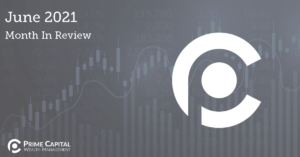
Quick Takes
● Global recovery lifts all boats. International bonds and stocks fell in June, but all major asset classes were up in Q2 as the global synchronized recovery continued. Economic activity is expansionary globally and earnings are improving globally.
● Dollar dependent. The direction of the U.S. dollar (USD) has historically been a key contributor to international asset’s performance. In May USD weakness led to international stock and bond outperformance, but in June USD strength led to international assets underperforming.
● The U.S. continues to lead the way. Whether it’s the economy, earnings or markets, the U.S. continues to lead the global recovery. June capped the fifth straight positive month for U.S. stocks and the fifth straight positive quarter, the best streak since 2017.
● Inflation and variants are keys to the outlook. Two of the biggest issues that will shape market and economic behavior in the second half of 2021 are 1) whether inflation is “transitory” or not, and 2) whether vaccinations can mitigate new COVID-19 variants sufficiently to avoid further restrictions.
Asset Class Performance
In a counter trend move from May, June saw the U.S. dollar jump 2.9% and that contributed to international equities and bonds being the only broad asset classes to drop in June. But for the second quarter all asset classes gained.

Stocks sail to records behind vaccinations & improving economies
Stocks closed out June, the second quarter, and the first half of the year with the S&P 500 hitting 4,297.50, an all-time high. It was the fifth consecutive month and the fifth consecutive quarter of positive returns for the S&P. That’s the longest quarterly streak since a nine-quarter stretch that lasted through 2017. And the performance of those five quarters has ranged from +6.2% to +20.5%. Research from Bespoke Investment Group shows that the only other time the S&P 500 has had at least five straight quarters of more than +5% gains was in the mid-1950s – and the following year its was up another +25%. Numerous tailwinds are behind the strong stock performance, with vaccination rates improving, economic activity solidly expanding, and earnings accelerating. More than 325 million COVID-19 vaccinations have been administered in the U.S. with now more than 57%of U.S. adults now vaccinated. Importantly, 90% of the 65+ age group, a cohort that represents over 80% of COVID-19 deaths, are 90% vaccinated. As a result deaths are down -93% from their January peak, a new pandemic low. Meanwhile vaccination campaigns continued to accelerate overseas with Europe now catching up with the U.S. and U.K. With economies opening robust demand for consumer goods has resulted in strong manufacturing activity and as COVID restrictions are lifted services activity is accelerating from consumers that are flush with cash from savings, stimulus checks, and expanded unemployment insurance programs. Earnings for the second quarter will start being reported in the next few weeks and they have a high hurdle after Q1 which was the best quarterly year-over-year earnings growth since Q1 of 2010. J.P. Morgan is forecasting an earnings surprise of +14.6% for S&P 500 companies for the second quarter. That’s lower than the last four quarters but still well above the long-run average of 7%. Moreover, Bespoke Investment Group notes that since June began stocks have reacted more positively to earnings reports than in Q1. For multi-asset class investors, the good news didn’t end with equities. The Bloomberg Barclays US Aggregate Index was up+0.7% in June and +1.8% for the quarter – its eleventh gain over the last twelve quarters and its best quarter since the depths of the pandemic in 2Q-2020. Investment Grade bonds id even better in June, rising 1.6% and +3.5% for the quarter. Bonds benefitted from narrowing yield spreads and declining Treasury yields.
after Q1 which was the best quarterly year-over-year earnings growth since Q1 of 2010. J.P. Morgan is forecasting an earnings surprise of +14.6% for S&P 500 companies for the second quarter. That’s lower than the last four quarters but still well above the long-run average of 7%. Moreover, Bespoke Investment Group notes that since June began stocks have reacted more positively to earnings reports than in Q1. For multi-asset class investors, the good news didn’t end with equities. The Bloomberg Barclays US Aggregate Index was up+0.7% in June and +1.8% for the quarter – its eleventh gain over the last twelve quarters and its best quarter since the depths of the pandemic in 2Q-2020. Investment Grade bonds id even better in June, rising 1.6% and +3.5% for the quarter. Bonds benefitted from narrowing yield spreads and declining Treasury yields.  Yields on 10-Year U.S. Treasury fell -13 basis points in June and -27 basis points over the quarter, to their lowest levels, 1.47%, since early March. Commodities also continue to work, gaining +1.8 in June and +13.3% for the quarter, the best quarter since Q4-2010, and the sixth positive quarter in the last seven. They’ve benefitted from a U.S. dollar that has declined in four of the last five quarters, though the buck bucked the trend in June, rising +2.9%.
Yields on 10-Year U.S. Treasury fell -13 basis points in June and -27 basis points over the quarter, to their lowest levels, 1.47%, since early March. Commodities also continue to work, gaining +1.8 in June and +13.3% for the quarter, the best quarter since Q4-2010, and the sixth positive quarter in the last seven. They’ve benefitted from a U.S. dollar that has declined in four of the last five quarters, though the buck bucked the trend in June, rising +2.9%.
Bottom Line: The bull market is now in its second year and positive trends on the vaccination, earnings and economic fronts are supportive of the breakout to new highs. An accommodative Fed should also continue to help support equities, even at stretched valuations.
Click here to see the full review.
—
©2021 Prime Capital Investment Advisors, LLC. The views and information contained herein are (1) for informational purposes only, (2) are not to be taken as a recommendation to buy or sell any investment, and (3) should not be construed or acted upon as individualized investment advice. The information contained herein was obtained from sources we believe to be reliable but is not guaranteed as to its accuracy or completeness. Investing involves risk. Investors should be prepared to bear loss, including total loss of principal. Diversification does not guarantee investment returns and does not eliminate the risk of loss. Past performance is no guarantee of comparable future results.
Source: Bloomberg. Asset‐class performance is presented by using market returns from an exchange‐traded fund (ETF) proxy that best represents its respective broad asset class. Returns shown are net of fund fees for and do not necessarily represent performance of specific mutual funds and/or exchange‐traded funds recommended by the Prime Capital Investment Advisors. The performance of those funds may be substantially different than the performance of the broad asset classes and to proxy ETFs represented here. U.S. Bonds (iShares Core U.S. Aggregate Bond ETF); High‐YieldBond(iShares iBoxx $ High Yield Corporate Bond ETF); Intl Bonds (SPDR® Bloomberg Barclays International Corporate Bond ETF); Large Growth (iShares Russell 1000 Growth ETF); Large Value (iShares Russell 1000 ValueETF);MidGrowth(iSharesRussell Mid‐CapGrowthETF);MidValue (iSharesRussell Mid‐Cap Value ETF); Small Growth (iShares Russell 2000 Growth ETF); Small Value (iShares Russell 2000 Value ETF); Intl Equity (iShares MSCI EAFE ETF); Emg Markets (iShares MSCI Emerging Markets ETF); and Real Estate (iShares U.S. Real Estate ETF). The return displayed as “Allocation” is a weighted average of the ETF proxies shown as represented by: 30% U.S. Bonds, 5% International Bonds, 5% High Yield Bonds, 10% Large Growth, 10% Large Value, 4% Mid Growth, 4%Mid Value, 2% Small Growth, 2% Small Value, 18% International Stock, 7% Emerging Markets, 3% Real Estate.
Advisory services offered through Prime Capital Investment Advisors, LLC. (“PCIA”), a
Registered Investment Adviser. PCIA doing business as Prime Capital Wealth Management
(“PCWM”) and Qualified Plan Advisors (“QPA”).
© 2021 Prime Capital Investment Advisors, 6201 College Blvd., 7th Floor, Overland Park, KS 66211.
Inflation: Transitory, Sustained, or Runaway?

The buzz word of the year in the financial industry has without a doubt been “transitory.” This is the label that Federal Reserve Chairman, Jerome Powell, Treasury Secretary, Janet Yellen, and many leading economists have placed upon the recent surge in inflationary pressure sweeping across the country. While inflation has been somewhat dormant coming out of the financial crisis in ’08-’09, it’s been painfully visible for anyone who has tried to build a deck, buy a used car, or hire new employees in recent months. Inflation can also have major implications for financial markets, as analysts and investors obsess over every word from the Federal Reserve trying to understand exactly when this unprecedented level of “easy” monetary policy will start winding down.
The argument from those in the “transitory” camp would suggest that this bump in prices was inevitable due to the massive disruption in the supply chain from the COVID-related shutdowns, coupled with a surge in demand from consumers as the economy springs back to life. The Federal Reserve sagely began preparing for this scenario almost a year ago, when they shifted their “inflation control” policy to seek an average rate of 2% over the long run, rather than a fixed target, giving themselves the flexibility to keep policy loose (interest rates low) even if inflations should spike for a few months or even a few years.
Those that fear runaway inflation would argue that this new approach could be dangerous. They are concerned that the massive amount of stimulus money sent directly to consumers in the last 12 months, funded by an ever-increasing mountain of debt, will cause prices to spin out of control. The consequence of this, they fear, would be a need for a more drastic movement upward in interest rates, as was seen in the 1980’s. This could indeed cause a severe recession and potentially a sharp decline in real estate prices as affordability would drop overnight.
So which side is correct? We will take a deeper dive into this topic in our quarterly newsletter, but in short, we fall somewhere in the middle. We’ve already seen evidence of cooling in some of the hottest commodities from a few months ago (lumber, copper, etc.). But it’s quite possible that other areas that have seen price increases, such as the cost of labor, might be more sustained. This “elevated” but not “runaway” level of inflation shouldn’t spell disaster for investors, but does require careful consideration in the portfolio construction process. As I mentioned above, stay tuned for more on this topic in the coming weeks, but please don’t hesitate to reach out to our team if you would like to discuss your personal thoughts and concerns in more detail.




